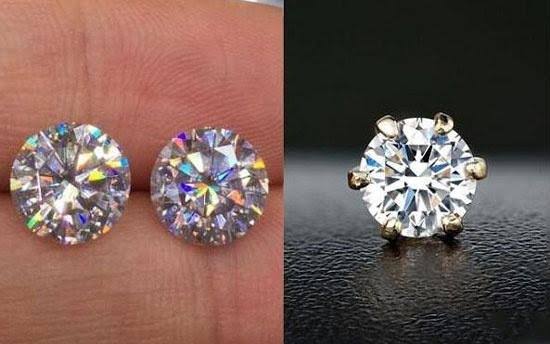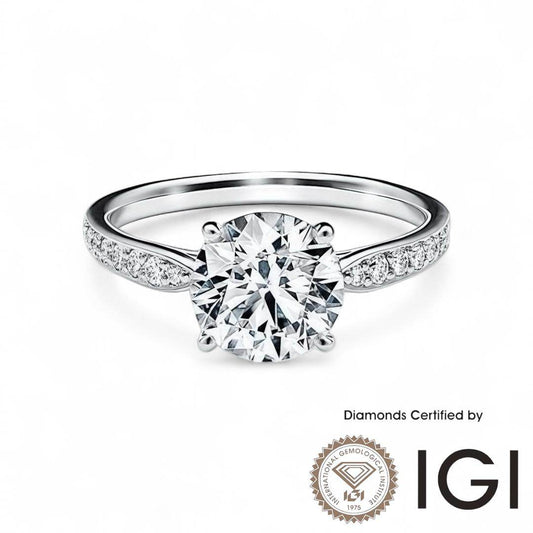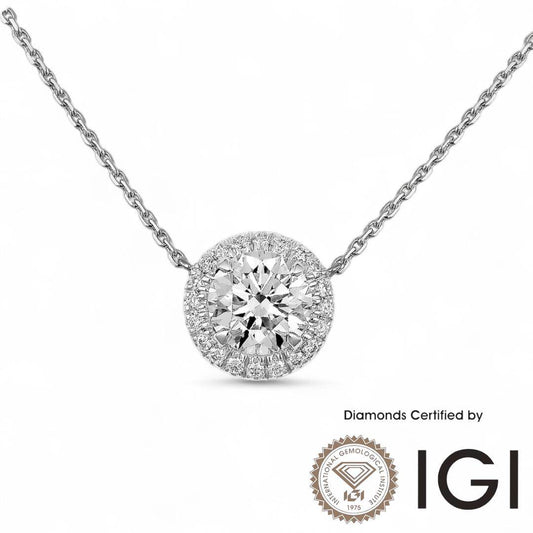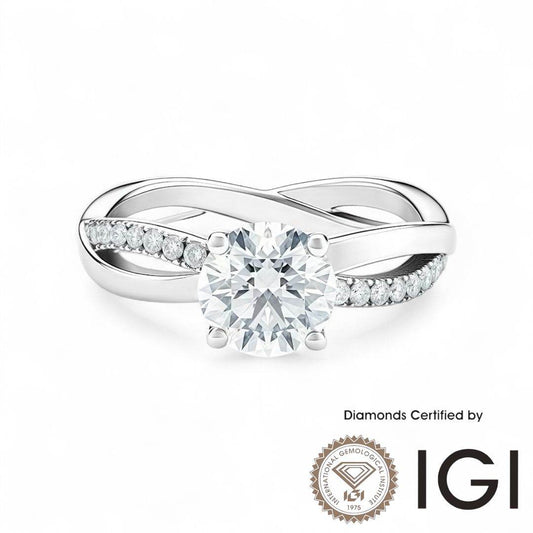How to Tell Real Diamonds from Fake: Easiest Way to Identify Lab-Grown Diamonds
Even without a jeweler’s loupe or diamond tester, you can still spot the difference between a lab-grown diamond and moissanite. As diamond experts, we can assure you that the distinctions are visible to the naked eye. With just two simple tests, you can immediately identify whether you’re looking at a genuine diamond or an imitation.
Quick Test #1: Observing Sparkle and Fire
The way a gemstone reflects light is the first and most reliable clue. Lab-grown diamonds shine in a fundamentally different way compared to moissanite’s intense rainbow-like effect.
Step 1: Find a Light Source
Use natural daylight, a lamp, or your phone flashlight.
Step 2: Tilt and Observe
Slowly move the ring or loose stone back and forth.
Step 3: Compare the Sparkle
Lab-Grown Diamond
Shows a bright, clear white brilliance combined with subtle, elegant fire. The overall effect is balanced, clean, and sophisticated — like a ballroom chandelier.
Moissanite
Displays exaggerated rainbow fire that overwhelms other light reflections. Think of a disco ball or flashy costume jewelry. This unnatural sparkle immediately signals a fake.
If you see rainbow flashes everywhere, it’s almost certainly moissanite.
Quick Test #2: Checking Facet Sharpness
The cutting precision of a gemstone reveals whether it’s a true diamond. Lab-grown diamonds have razor-sharp, well-polished facets. Moissanite often appears slightly rounded and less defined.
Step 1: Use Magnification
Examine the facets and girdle using a magnifier or a smartphone camera zoom.
Step 2: Check Sharpness
Lab-Grown Diamond
Hardness is 10 (Mohs scale). Facets are crisp, perfectly polished, and precise even under magnification.
Moissanite
Hardness is about 9.25, slightly softer than diamond:
- Edges may appear rounded, blurry, or less sharp, especially after wear.
- Polish may be imperfect, showing minor scratches or waxy sheen.
- Over time, this leads to a cloudy or dull appearance.
Blunt edges, blurred facets, or rough polish? That’s almost certainly moissanite.
Why Moissanite Is Not an Ideal Diamond Alternative
“Disco Ball Effect”
Overly strong rainbow fire makes the stone look cheap and artificial.
Lower Durability
Moissanite scratches easily and loses polish over time, becoming dull.
Color Issues
Many moissanites carry yellow, gray, or greenish tones, especially under natural light or in larger stones.
Cheap Appearance
Excessive fire + imperfect cut + color flaws = obvious imitation, lacking diamond’s elegance.
Why an IGI Certificate Is Essential (Your Anti-Counterfeit Guarantee)
Authentication
IGI certifies the gemstone is carbon (diamond), not silicon carbide (moissanite).
4C Grading
Cut, Color, Clarity, Carat — ensures transparency of quality and value.
Laser Inscription
Most IGI diamonds have the report number inscribed on the girdle.
Online Verification
You can verify your certificate instantly at IGI Official Website.
No certificate = high risk. Some sellers may pass off moissanite as diamonds at premium prices. IGI is your safeguard.
Summary: Choose True Brilliance
Don’t be fooled by claims that “you can’t tell the difference.” Moissanite’s excessive fire, blurry facets, and low polish fail to match the professional appearance and durability of lab-grown diamonds.
Moissanite is just a shiny imitation. Lab-grown diamonds are the true choice — timeless, durable, and scientifically verified.
Insist on genuine diamond brilliance with IGI certification.
Frequently Asked Questions (FAQ): Lab-Grown Diamonds vs. Moissanite
Q1: Is moissanite a good alternative to lab-grown diamonds?
A: Moissanite is cheaper, but lacks the brilliance, durability, and elegance of a lab-grown diamond. It is easy to spot as an imitation.
Q2: Does moissanite become cloudy over time?
A: Yes. Due to lower hardness, its edges wear down over time, causing it to lose its polish and appear dull.
Q3: Can professional jewelers tell the difference?
A: Yes. Professionals use diamond testers and magnification to examine brilliance and facet sharpness, making it easy to distinguish moissanite from diamonds.
Q4: Do lab-grown diamonds need an IGI certificate?
A: Yes. IGI certification provides authenticity and 4C grading, ensuring full transparency and protecting your investment.
Author & Publication Information
Author Bio: Winston Wu, Marketing Director at Kardias Fashion Group, diamond and luxury goods expert. Since 2012, he has collaborated with top European brands including Versace, Moschino, Hugo Boss, and Roberto Cavalli, gaining deep expertise in lab-grown diamonds.
- Author: Winston Wu, Luxury & Diamond Expert
- Publisher: Luxury Boutique Madison Avenue
- First Published: August 2025
- Last Updated: September 2025
Disclaimer: This article is based on market data from January 2025. Actual prices and availability may vary. Always confirm with the vendor. This is not investment advice.





